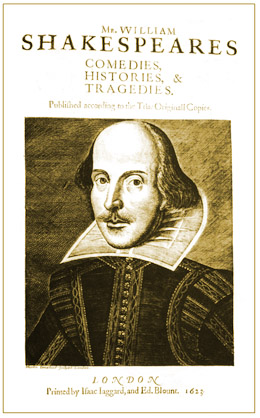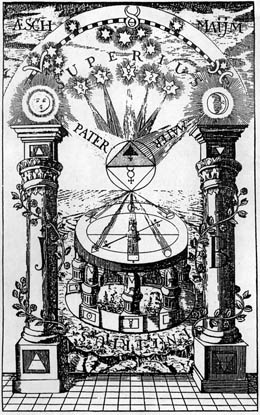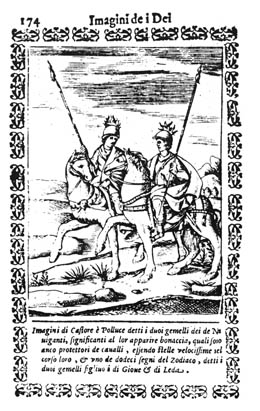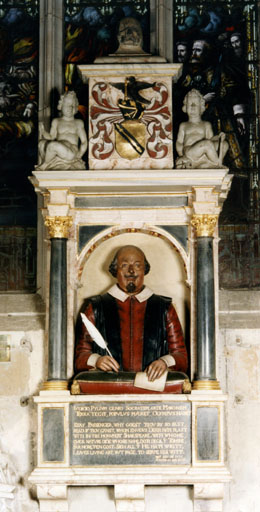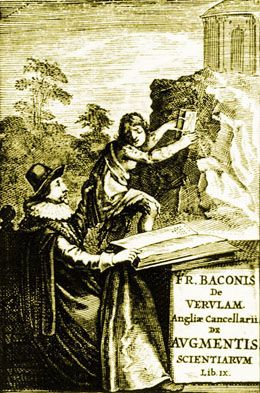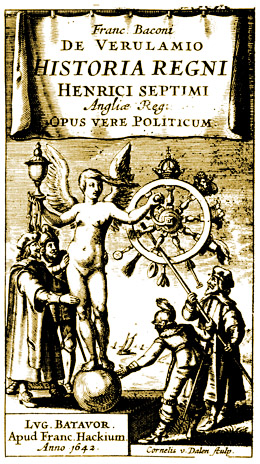Shakespeare Authorship
“So did Philosophy, entangled in the subtleties of Schoolmen seek Bacon as a deliverer… He renewed her, walking humbly in the socks of Comedy. After that, more elaborately he rises on the loftier buskin of Tragedy…”
R.P.: Elegy 4, Manes Verulamiani – 1626
The Mystery
The authorship of the Shakespeare works is, for many reasons, open to question. Although there are still many people who do not want to address the problem, there are many now who are doing so, and in the process both researching and uncovering many things previously unknown or ignored. The result is an increasingly better knowledge not only of history but also of other things, plus a much deeper appreciation of and insight into the Shakespeare works. Indeed, the Shakespeare Authorship Question appears to work as a mystery, in the classical sense of the word, being both educational and initiatory. Moreover, it appears to have been deliberately designed as such.
The greatest mystery of all is the mystery of the Divine Author of the Universe concealed in the Author's own creation. To search for this Author and the laws created by this Author is the search for truth. Man-made sacred drama or mysteries were designed to imitate that of the Divine Author so that, by discovering various truths in the drama, both actors and audience could learn how to search out, discover and enact the truths in the greater mystery of life.
The Shakespeare Authorship Mystery would appear to be a fine example of one of these man-made mysteries, teaching us, by means of searching for the true author of the Shakespeare works, how to search for the truths of life and ultimately the true Author of All.
The name of William Shakespeare, variously spelt, printed on the title pages of poems, sonnets and plays, plus the identification of him made by the Shakespeare Folio and the Shakespeare Monument at Stratford-upon-Avon, would seem to point to the actor and businessman Will Shakspere of Stratford-upon-Avon as the author. Yet, despite the mammoth amount of research done, absolutely nothing has been discovered about Will Shakspere to indicate, let alone prove, that he really did write the Shakespeare works attributed to him, or that he was a poet of any kind. Indeed, all evidence points to the truth of the statement made in The Great Assises Holden in Parnassus by Apollo and His Assessours, 1 that “William Shakespeere” is “a mimic….not a poet”. 2
However, we are not left completely in the dark about the authorship, as various clues have been carefully left to us, so that we can follow the threads. It is like a game of hide and seek that is also a labyrinthine puzzle.
Clues
The general assumption of who the author Shakespeare was is fundamentally based on the evidence provided by the 1623 Shakespeare Folio and the Shakespeare Monument in Holy Trinity Church, Stratford-upon-Avon, with the former referencing the latter. This is a good and obvious place to start.
The introductory pages of the Shakespeare First Folio and the inscription on the Shakespeare Monument that refer to the author are cleverly constructed, so that they appear to say one thing but in reality say something quite different. In other words, an illusion masks a reality, just like any dramatic production.
Shakespeare (the author) even demonstrates how this ‘trickery’ effectively works, for in many of his plays he has one or more of the characters putting on a disguise and pretending to be someone whom they are not, so that not only is there an actor pretending to be a fictional character but also that character is pretending to be another character.
Shakespeare Folio Portrait Poem
The illusion—and the key to finding the truth beneath the disguise—starts with the very first page of the 1623 Shakespeare Folio of Comedies, Histories and Tragedies. Instead of a frontispiece, this first page of the Shakespeare Folio is printed with a short 10-line poem addressed “To the Reader”. It is printed on the obverse of the first sheet of the prefatory pages of the Folio and followed by the title page printed on the obverse of the second sheet. 3 It is a somewhat strange or cryptic poem, unusually positioned, and is signed “B.I.”. These initials are the same as those of Ben Jonson (the letters I and J were treated as the same letter in the Elizabethan alphabet), and so the poem is normally attributed to Jonson as a result.
To the Reader.
This Figure, that thou here seest put,
It was for gentle Shakespeare cut;
Wherein the Graver had a strife
with Nature, to out-doo the life:
O, could he but have drawne his wit
As well in brasse, as he hath hit
His face; the Print would then surpasse
All, that was ever writ in brasse.
But since he cannot, Reader, looke
Not on his Picture, but his Booke.
B.I.
This opening poem, which refers to the portrait of Shakespeare on the title page of the Folio, is a beautifully crafted example of deliberate ambiguity, offering two very different meanings. For instance, taken at face value, the verse implies that the artist worked hard to surpass nature in portraying the face of Shakespeare. The alternative reading, however, tells us that the engraver tried very hard to do out or efface 4 the life or reality of Shakespeare and, as a result, has successfully hidden the face of the true author of the Shakespeare plays (“hit” is the old past participle of hide, with the meaning ‘hid’ or ‘hidden’) 5 —a reading that is supported by the mask-like portrait of Shakespeare on the Folio’s title page, plus other cryptographic signs.
The poem concludes by saying that if we want to see the wit of the author, we should look not on his picture, but on his book, meaning that we won’t find the author’s wit in the picture, but we will find it in the book (i.e. the plays). This comment seems straightforward enough, but in fact it also gives a subtle hint that the person portraying himself (or being portrayed) as Shakespeare is a disguise—a mask or veil—and that we should look behind or beyond it in order to find the real author. The signature “B.I.” then follows on the line below. It is noteworthy that these initials are also those of Boaz and Jachin, the names of the two famous pillars at the entrance to Solomon’s Temple, each cast in brass (note the emphasis on “brasse” in the poem), which Freemasonry calls “The Great Pillars”. Once one has passed between the Great Pillars and entered the porch of Solomon’s Temple, the next thing to do is to enter the temple by drawing aside the veil. In this temple, in the Holy of Holies, we will find the Presence of the Author of All.
Trophonian Den
The supposition that “B.I.” might be the initials of Ben Jonson is also apt, since in The Great Assizes Holden in Parnassus Ben Jonson is listed as the “Keeper of the Trophonian denne”. A keeper is a guardian—a gatekeeper or doorkeeper. The Trophonian den is an oracle centre associated with Trophonius. By entering the Trophonian Den, profound knowledge or wisdom is said to be revealed to the properly prepared initiate—a wisdom which begins with melancholia and leads to enlightenment.
With Ben Jonson guarding the entrance to the Shakespeare Folio of plays, the collection of plays can be seen as symbolising the Trophonian Den. It is not by chance, therefore, that an underlying theme of the Shakespeare plays, particularly the comedies, is that of starting in a state of melancholia and ending with some kind of revelation or illumination. This is the same as the Masonic theme of travelling from darkness to light, only in this instance the place of enlightenment is represented by Solomon’s Temple, whose entrance is guarded by the Great Pillars, “B.I.”.
Besides being acknowledged as a son of Apollo, Trophonius was equated with Mercury, or Hermes Trismegistus, whose surname thus became Trophonius (i.e. Mercurius Trophonius). Trophonius and his brother Agamedes were the architects of Apollo’s Temple at Delphi. There is an old tradition that the architect of a temple should be buried in its foundations—a statement that has profound meaning and should not be taken too literally! 6
The naming of Ben Jonson as the “Keeper of the Trophonian denne” is entirely in keeping with the historical fact that Ben Jonson held the position of Chief Gentleman Usher to Sir Francis Bacon when the latter was Lord Chancellor, being named as such in the 1618 list of Bacon’s household. Bacon referred to Jonson as “my man John”, and even paid for Jonson’s son to attend Eton (mentioned in an account of Bacon’s receipts and payments from 24th June to 29th September 1618).
Apollonian Swan
In his eulogy “To my beloved, The AVTHOR Mr William Shakespeare” that is included in the prefatory pages of the Shakespeare Folio, Ben Jonson praises highly the author Shakespeare, referring to the author as the Soul of the Age, the Sweet Swan of Avon, a Constellation and the Star of Poets, who is like Apollo and Mercury.
He was not of an age, but for all time!
And all the Muses still were in their prime,
When like Apollo he came forth to warme
Our eares, or like a Mercury to charme!
Mercury is known as the Morning Star, the eloquent messenger, communicator, quick thinker and herald of the Day Star. Mercury holds this role as twin to Venus, who is also known as the Morning Star. The Day Star is Apollo (the Sun), god of wisdom and illumination, and leader of the choir of Muses. His partner is Pallas Athena, the Spear-shaker and Tenth Muse, goddess of wisdom and philosophy. Apollo is associated with the heart; Mercury with the mind.
Sweet swan of Avon! what a sight it were
To see thee in our waters yet appeare,
And make those flights upon the bankes of Thames,
That so did take Eliza, and our James!
"Sweet Swan" is the description of a great poet, like Orpheus, who was famously symbolised as a swan, with "sweet" referring to sweet or beautiful singing.
The name "Avon" can be misleading. Because of the reference to Shakespeare's "Stratford Moniment" in Leonard Digge's poem, "To the Memorie of the deceased Author Maister W. Shakespeare", which follows on after Ben Jonson's tributary poem, it is usually mistakenly assumed that "Avon" here refers to Stratford-upon-Avon's river.
However, if the four lines of what is one sentence are read more carefully, we can see that "Avon" actually refers to the river Thames. This is because the Celtic name for a river, any river, was 'avon', and Hampton Court Palace, which is on the banks of the river Thames, lies on the site of Hampton, a name that is a corrupted form of Anglo-Saxon Avonton (‘settlement by the river’) which replaced the original Celtic name Avondunum (‘fort by the river’). William Campden, in his book Britannia, refers to this, quoting historian John Leland who explained that Hampton was a shortening of the Romano-Celtic name Avondunum, meaning a fortified place (dunum) by a river (avon), which “the common people by corruption called Hampton.”
It was at Hampton Court Palace where Queen Elizabeth and King James often enjoyed elaborate entertainments in the Great Hall, including performances of plays such as the Shakespeare plays. Certain performances are known about from records that survived, whilst others are not. Of what is known, during the Christmas season of 1603 (which stretched into January 1604, modern dating), the King's Men were paid £53 for four plays enacted before the King, and two more enacted before Prince Henry. These included A Midsummer Night’s Dream. In 1604 (or 1605) The Moor of Venice (Othello) was performed on Hallowmas Day (1 Nov), The Merry Wives of Windsor on the Sunday after Hallowmas, Measure for Measure on St Steven’s Night (26 Dec), The Comedy of Errors on Innocents Night (28 Dec), and Love’s Labour’s Lost. In 1606, “Macbeth” was first performed in front of the King.
But stay, I see thee in the Hemisphere
Advanc'd, and made a Constellation there!
Shine forth, thou Starre of Poets...
The “Hemisphere” is that of the Northern Hemisphere or sky. The "Constellation" is that of Cygnus, the Swan, symbol of a great poet-initiate and an attribute of Apollo, the Day Star that is the “Starre of Poets”. Normally the Day Star refers to the Sun, but, by linking the “Starre of Poets” with the constellation of Cygnus, Jonson is probably also referring to the nova that dramatically appeared in Cygnus in 1600, which caused a big stir and was twinned in Rosicrucian symbolism with the 1604 supernova in Ophiuchus. This Cygnus nova could still be seen with the naked eye in 1623. 7
The Gemini Spear-shakers
The Swan is also an emblem of the Gemini, the ‘Twins’, who, according to the myth of Leda and the Swan, were Leda’s children. They are allegorically referred to as swans hatched from swan’s eggs, but normally portrayed in human form, either as children or as knights with spears and known as Spear-shakers. There were two sets of twins, hatched from two swan eggs. One set of twins, brother and sister, were immortal twins; the other set, brother and sister, were mortal twins. It is the two brothers, one mortal, the other immortal, who become the Spear-shakers, when the mortal brother has been raised immortal by the sacrificial love of the immortal brother. They become the immortal-mortals or mortal-immortals.
Twinship or partnership, the Gemini theme, is the major key to the Shakespeare Mystery. Not only does this theme run throughout the Shakespeare poems, sonnets and plays in a variety of ways, but each of the primary, authorised publications of the Shakespeare works (the poems, sonnets and folio of plays) is prominently ‘signed’ with a Gemini headpiece. Moreover, Shake-speares Sonnets refer to two poets. Not only is the title name "Shake-speares" plural, but also the 'Rival Poets' sequence (Sonnets 78-86) infers that there are two poets, which Sonnets 83 and 86 make particularly clear, with Sonnet 83 ending with the line, "Than both your poets can in praise devise."
The signature “B.I.” on the opening poem of the Shakespeare Folio, as representative of the Great Pillars, is actually the Gemini signature, as these twin entrance pillars signify the Gemini and inform their astrological sigil.
Shakespeare Monument Gateway
Such pillars adorn the Stratford-upon-Avon Shakespeare Monument and are crowned with sculptures of the Gemini, just to make the signature absolutely plain to sight, whilst the bust of Shakespeare stands between these pillars in the architectural representation of the gateway to the Shakespeare ‘temple’. Like the portrait of Shakespeare on the title page of the Shakespeare Folio, this bust of Shakespeare stands like a gatekeeper or veil to the mystery beyond. Emphasising this connection with the Folio portrait and symbolism, the face of Shakespeare portrayed on the bust looks lifeless, possibly being derived from a death mask.
Author and Actor
There are many clues to be found that give entrance into this mystery, but the last one to mention in this brief introduction is that not only does the Shakespeare Monument depict the Gemini in the form of the twin pillars and the sculptured twin boys above them, but also the inscription on the monument powerfully conveys the idea that there are two Shakespeares who relate to each other as the immortal and mortal, like the Gemini.8 The first two lines of the inscription describe the author and, in the second line, refer to him as an immortal, dwelling in Olympus.9 The last two lines of the inscription refer to the actor, who is mortal and deceased. Usually this is interpreted as meaning that, having died, Shakespeare's soul has gone to heaven whilst his body has been interred in the earth. This, of course, is the seemingly obvious interpretation, the outer appearance—but not all is as it seems.
The first line of the Shakespeare Monument inscription describes the author Shakespeare as “a Pylus in judgement, a Socrates in genius, a Maro in art”. Nestor, King of Pylus, was a renowned statesman, judge and adviser of kings and princes.10 Socrates was acclaimed in his own time as the greatest of all philosophers and proclaimed by the Delphic oracle as the wisest of mankind. He was famed as an orator and, attended by a number of pupils (including Plato), he introduced moral philosophy and advocated the inductive procedure. Virgil, surnamed Maro, was not only a scholar-poet acclaimed as the Prince of Latin Poets but also an initiate of the classical mysteries as practised at Cumae, Naples, allusions to which can be found in his writings. None of these three great men were known to have written a play, in the sense of claiming authorship or signing any plays with their own name; but Socrates is suspected to have written tragedies masked by his pupil Euripides, and Virgil, according to the English poet Edmund Spenser, wrote pseudonymously under the name of Tityrus.
The choice of Pylus, Socrates and Maro with which to describe (and hence identify) the author Shakespeare is not only challenging to the idea that Will Shakspere was the author (and in fact dismisses him as a possibility), but also forms a Hermes Trismegistus description. Hermes is said to have been “thrice great” because he had “the power and fortune of a king, the knowledge and illumination of a priest, and the learning and universality of a philosopher”.11 Nestor was king of Pylus, Virgil was an initiate (i.e. priest) of the mysteries, and Socrates was a renowned philosopher. In other words, the inscription is likening the author Shakespeare to Hermes Trismegistus, as well as identifying the actual historical person who was the real author.
In fact, the whole three-part monument inscription is Hermetic in its design, suggesting the ‘Three Worlds’ of Hermeticism and conveying the idea (derived from the Corpus Hermeticum) that the author Shakespeare is a Hermes Trismegistus and the actor Shakespeare (Shakspere) is his pupil.12
The Author Shakespeare
If we follow the hint given in the portrait poem of the Shakespeare Folio and look to see what the internal evidence of the Shakespeare plays tells us about the author, we find that the author Shakespeare was a great poet and scholar, a Neoplatonic philosopher, a hermeticist and cabalist, a Cambridge alumnus,13 an expert lawyer and member of the Inns of Court,14 a courtier, a parliamentarian, a statesman, a foreign traveller, and a multi-linguist who had the ability to read some of his source material in French, Italian and Spanish as well as in Latin, Greek and Hebrew. He had detailed knowledge of the affairs, manners, behaviour, entertainments, habitations and way of life of the royal court and nobility, and of places, people, politics, history, geography and horticulture, in France and Italy as well as in England. Then, in the final play of Henry VIII, he shows knowledge of certain things normally only known to a Lord Chancellor and his privileged circle.
There is actually a person, and only one person, who fits this extraordinary but apt description: Sir Francis Bacon, Baron Verulam of Verulam, Viscount St Alban. But, as Bacon himself declares, great works cannot be accomplished by one person only; and, indeed, he had a team of poets, writers, amanuenses and intelligencers working for and with him for much of his life. In tributes to him, he was acknowledged as the leader of the poets and their muses, their Apollo and Daystar.
© Peter Dawkins, FBRT
(latest revision 21/03/2024)
1. The Great Assises holden in Parnassus by Apollo and his Assesours (1645), attributed to the poet and satirist George Wither.
2. To mimic (v) = to simulate, impersonate, counterfeit. An actor is a mimic. Someone pretending to be someone else is a mimic.
3. The reverse of each sheet is blank.
4. The literal meaning of ‘out-do’ (as in the equivalent Dutch word ‘uitdoen’) means to erase or efface.
5. e.g. exactly as we find used by Chaucer in ‘The Squires Tale’, Canterbury Tales, ii, 512-3:-
Right as a serpent hit hym under floures
Til he may seen his tyme for to byte.
6. This esoteric tradition of the architect being buried in the foundations of the temple is, for instance, portrayed and acted out in the Royal Arch Degree of Freemasonry.
7. P Cygni (34 Cyg) is a variable star in the constellation Cygnus that was first discovered by Willem Janszoon Blaeu in 1600, shining at 3rd-magnitude.. The designation "P" was originally assigned by Johann Bayer in Uranometria as a nova. The nova was the subject of careful study by Kepler, who in 1606 published a treatise about it: Astronomical Account of a 3rd-Magnitude Star in Cygnus, unknown before sixteen hundred, which continues to shine.
8. The Gemini (‘Heavenly twins’) are comprised of Pollux, the immortal twin, and Castor, the mortal twin.
9. The first two lines of the inscription are in Latin: "Iudico Pylium, genio Socratem, arte Maronem: / Terra tegit, populus maeret, Olympus habet."
10. This is confirmed by the Shakespeare plays, which are not only full of legal terms and references, but the author writes as if law was natural to him and true justice a major concern. Moreover, the plays and some of the sonnets display a profound comprehension of politics, statesmanship, rulership and even kingship.
11. Francis Bacon, Advancement of Learning (1605). Derived from the Pymander, which states that "they called him Trismegistus because he was the greatest philosopher and the greatest priest and the greatest king".
12. Most of the Corpus Hermetica texts are presented in the form of a dialogue in which a teacher enlightens a disciple. In the first book it involves a discussion between Pymander (the Nous or Divine Mind) and Hermes, in which Pymander teaches the secrets of the universe to Hermes. In this context, Pymander is the immortal, Hermes the mortal. Later books are generally of Hermes teaching others such as Asclepius and his son Tat. In this latter context, Hermes is the immortal, his pupil the mortal.
13. i.e. educated at and a graduate of Cambridge University, which fact is confirmed by a contemporary scholar, William Clerke, who lists "sweet Shak-speare" in his Polimanteia as one of the alumni and a fine classical scholar.
14. The jargon often used in the plays is that of the Inns of Court, the seats of legal training and practice in London.
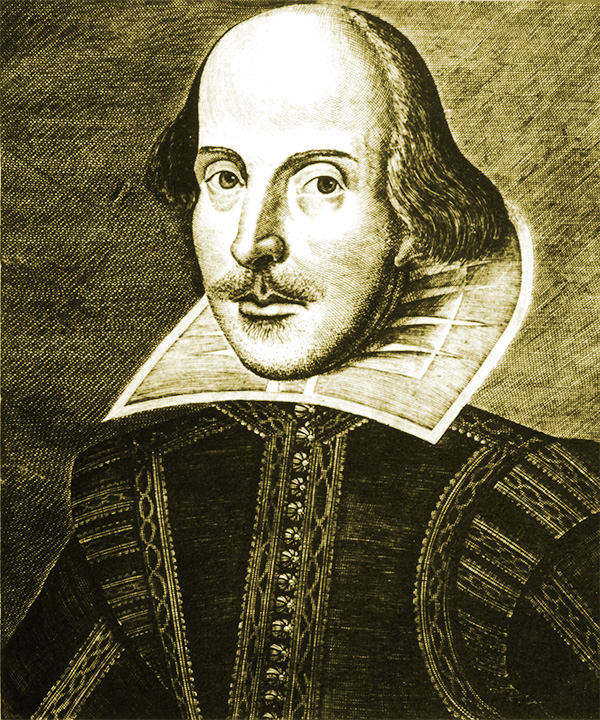
- The Name William Shakespeare
- What's in a Name?
- Shakespeare Authorship Questions
- Tributes to Sir Francis Bacon
- Knights of the Helmet & Comedy of Errors
- The Shake-scene
- The Shakespeare Circle
- The Secret Signature
- The Shakespeare Gemini Headpieces
- Beauty, Truth and the Gemini
- Sir Francis Bacon, the Third Plato
- Francis Bacon, Shakespeare & the Earl of Essex
- The Northumberland Manuscript
- The Philosopher and Secret Poet
- The Stratford Shakespeare Monument

